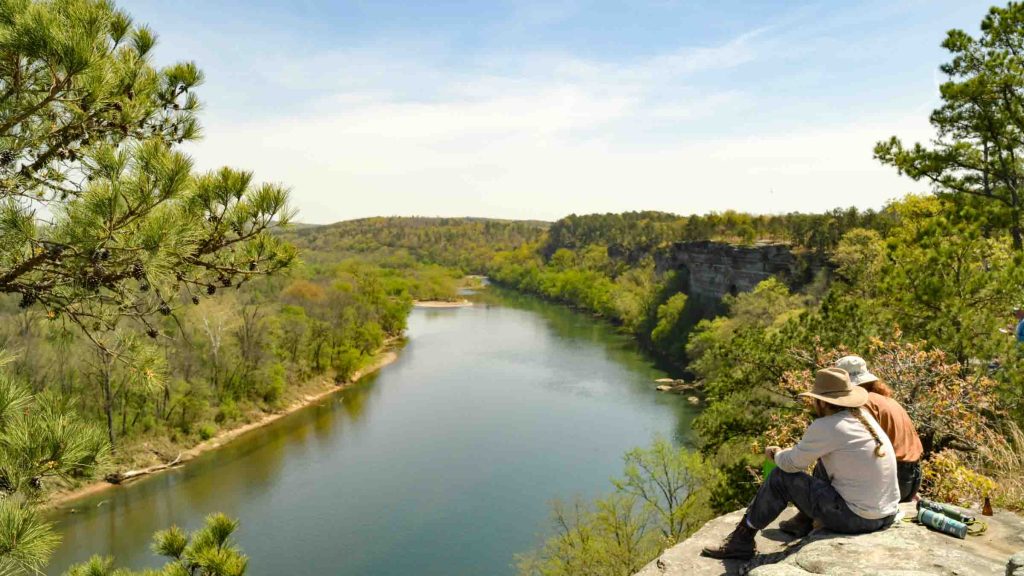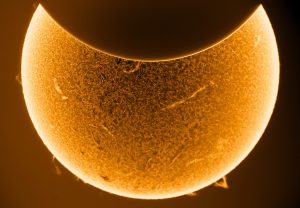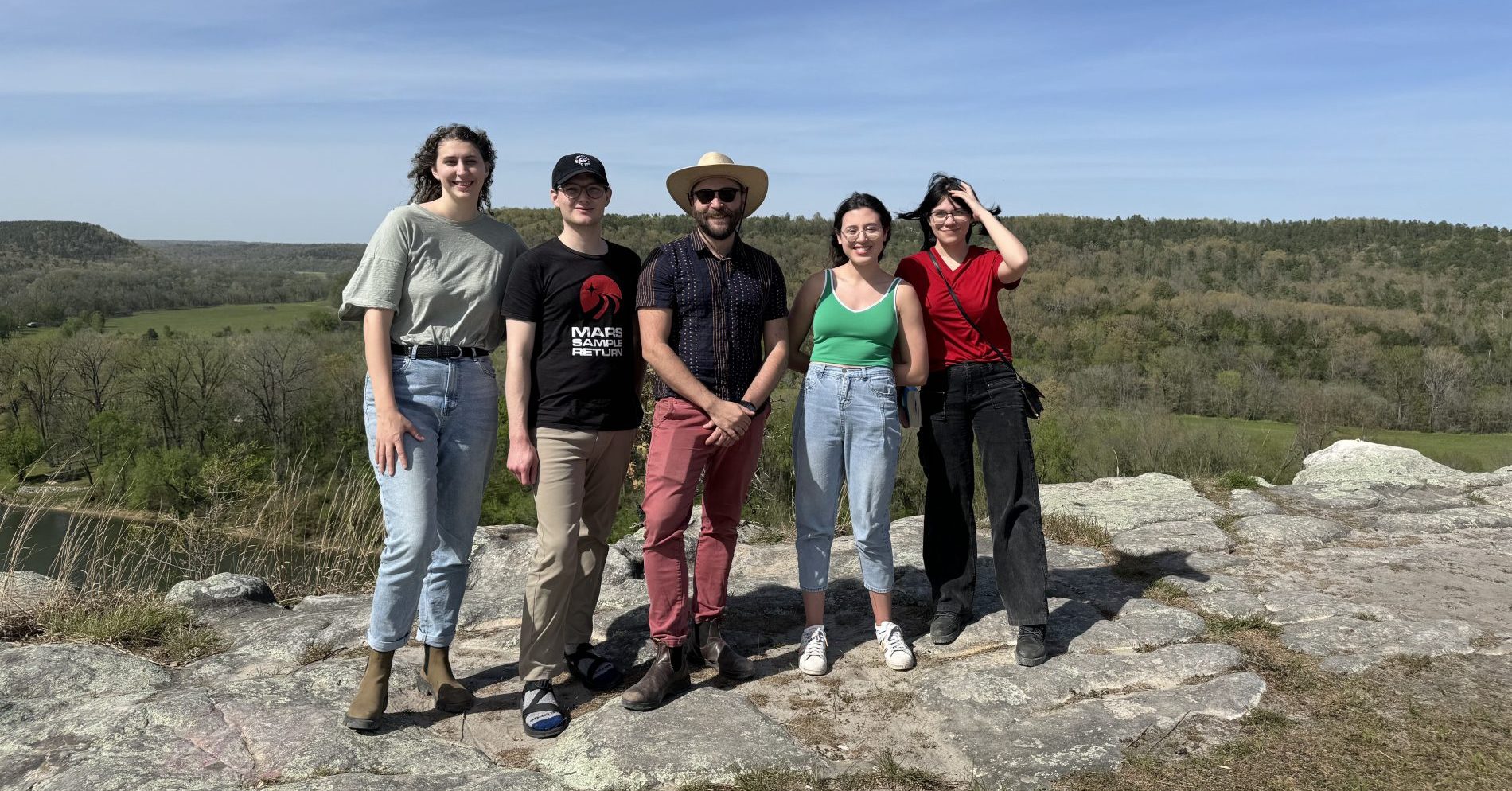In early April 2024, four UW Earth and Space Sciences graduate students, Alysa Fintel, Ula Jones, Andrew Shumway and Haskelle White-Gianella, traveled with Assistant Research Professor Baptiste Journaux across the Midwest to witness a life-changing total solar eclipse – the last to be seen in the U.S. for the next 20 years. College of the Environment multimedia producer Sarah Smith joined to document the experience.
While a partial eclipse was observable from Seattle, cloud cover permitting, the group traveled from Seattle to Missouri and finally to Arkansas to reach the center of a narrow 115-mile band of totality stretching from Texas all the way to Maine. In this zone, the sun is fully covered by the moon, creating up to four minutes of darkness in the middle of the day. The moments preceding totality are characterized by the ability to see the solar corona, the outermost region of the sun’s atmosphere, with the naked eye. “The sun is reaching its peak maximum solar activity in its 11-year cycle. During the solar eclipse we are going to be able to see really cool features like the solar corona,” explained 1st-year PhD student Haskelle White-Gianella. “It is an amazing life experience for people who study Earth and planetary science,” says Journaux. “This is one of the most rare, and probably one of the most awesome, things you can see on Earth in terms of astronomical observation”.
Though the group was traveling to witness an astronomical phenomenon above, they also took time to understand the local geology beneath their feet. Southern Missouri and Northern Arkansas are made up of rolling hills of limestone and dolomite – carbonate-rich rocks that are remnants of an ancient sea floor from 400 million years ago.

Along the way, the group stopped to explore caves that were carved into the limestone by millions of years of erosion by rain water. Underground, the group saw unique limestone features as well as fossilized remains of small sea creatures that once lived in the ancient ocean. It was an important opportunity for the planetary scientists to get out in the field and get some hands-on experience. Andrew Shumway, 6th-year PhD candidate, studies how water, salt and soil can interact to make liquid water possible on Mars. “Driving through the dolomite limestone layers in the Ozarks and thinking about my research on Mars, where we are also seeing carbonates, and about what environments could deposit those, was a useful educational and research experience for me.”

The group brought several specialized cameras with them to safely photograph the Sun through the stages of the eclipse. They used a telescope equipped with a hydrogen-alpha filter – which only allows through light of one specific wavelength – to photograph activity in the Sun’s lower atmosphere, known as the chromosphere. The team stayed in Springfield, Missouri the day before the eclipse, so they would be able to enter the path of totality from multiple different angles depending on the cloud coverage day-of. “Following weather predictions from the night before and last-minute predictions at 4 a.m., we ended up at Calico Rock, Arkansas after three hours of driving, where we were able to observe totality without clouds and in perfect conditions, standing on top of beautiful fossilized beach sandstones from 460 million years ago,” Journaux explained.
“Before the eclipse, we could see a ‘sunset’ for a while, but once totality hit, the sky instantly became a dark shade of blue” describes White-Gianella. “Everyone watching with us started cheering. I could feel everyone’s excitement and joy even though my focus was on the sun. I think everyone around us was just as awestruck and emotional as we were”. Temperatures dropped 5-10 degrees F from the start of the partial eclipse to totality, and the darkness was comparable to twilight, the time after sunset when the sun partially illuminates the atmosphere, White-Gianella explained. “My favorite part of the eclipse was the part where we could take our glasses off and see Venus and Jupiter,” says 5th-year PhD student Alysa Fintel. While Venus and Jupiter were visible to the naked eye, seeing Jupiter’s moons required binoculars.
“I found myself looking around during totality and just trying to take in that unique environment,” described Ula Jones, a 1st-year PhD student working with Journaux. Ula is curious about where life could exist on other worlds outside of the solar system, and her research focuses on describing the interiors of water-rich exoplanets using fundamental properties of high pressure ice. As a participant in the UW Astrobiology Program, she is excited to contribute to discussions about the potential habitability of icy moons and exoplanets. “UWAB provides a great interdisciplinary research setting that I really benefit from; for instance, my work spans topics between astronomy, oceanography, and ESS, all of which are well represented departments within the program.”
“This was such an unique opportunity to have with graduate students of our department, to share this experience with them,” says Journaux. “I think it will help them transmit their love of eclipses to their future students.”

College of the Environment published a similar article.
UW News published this related Q&A with Journaux about the trip.